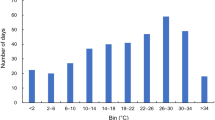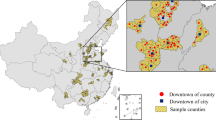Abstract
Our interest is in electricity demand and the temperature aspects of climate change. Electricity consumption is of interest both from the perspectives of adaptation to climate change and emission reductions. We study the relationship between European electricity consumption and outdoor temperature and other variables, using a panel data set of 31 countries. Apart from providing a rare quantitative window into adaptation, the study contributes demand system parameters with respect to price and income. The results suggest that weather has a statistically significant effect on electricity demand, with effects that are of plausible magnitude. In a simulation of climate change for the next 100 years—other factors held constant—we find that the demand for heating will decrease in Northern Europe while the demand for cooling will increase in Southern Europe. In countries like Cyprus, Greece, Italy, Malta, Spain, and Turkey the net effect of increased cooling outweighs decreased heating consumption whereas in most of Europe the opposite holds. The largest estimated partial impact is 20%, which predicted increase in adaptive consumption for Turkey and decrease in adaptive consumption for Latvia. Estimated elasticities with respect to income and price are 0.8 and minus 0.2 respectively: plausible in the light of the literature. As a discussion item, we add that electricity consumption changes due to temperature change likely will be small compared to those due to other factors, such as changes in income, demography and technology. The study does not include effects of climate change other than through electricity consumption.
Similar content being viewed by others
Notes
Volume 29, Number 6, of Energy Economics has a number of interesting papers that investigate the direction of causality between income and electricity consumption in many countries.
Data for some years missing for specific countries are as follows: Bulgaria (1994–2003), Croatia (1994–2005), Cyprus (1994–1998), Czech Republic (1994–1998), Denmark (1994–1995), Estonia (1994–2001), Iceland (1994–2005), Latvia (1994–2003), Lithuania (1994–2003), Norway (1995), Poland (1994–2000), Romania (1994–2004), Slovakia (1994–1997), Slovenia (1994–1995), Sweden (1995–1996), Turkey (1994–1997), and the United Kingdom (1994–1995). The EIA has data (in kWh per US$) for the Czech Republic (1998–1999), Poland (1998–2000), and Romania (1998–2005). We use the Euro–US$ exchange rate from Eurostat to convert the prices into Euro per kWh. IEA (2002) provides the 1995 data for Czech Republic, Denmark, Hungary, Norway, Poland, Slovakia, Sweden, and the United Kingdom in local currency. IEA (2007) also has some the missing price data.
Although they are not reported here, these results are available upon request.
References
Anderson KP (1973) Residential demand for electricity: econometric estimates for California and the United States. J Bus 46:526–553
Asadoorian MO, Eckaus RS, Schlosser CA (2008) Modeling climate feedbacks to electricity demand: the case of China. Energy Econ 30(4):1577–1602
Benestad R (2005) Climate change scenarios for northern Europe from multi-model IPCC AR4 climate simulations. Geophys Res Lett
Benestad R (2008) Heating degree days, Cooling degree days, and precipitation in Europe: Analysis for the CELECT-project. Report for the Norwegian Metereoroligical Institute.
Berndt RE (1978) The demand for electricity: comment and further results. MIT-EL 78-021WP.
Bertoldi P, Atanasiu B (2007) Electricity consumption and efficiency trends in the enlarged European Union. Institute for Env. and Sustainability, European Commission Joint Research Center.
Bigano A, Bosello F, Marano G (2006) Energy demand and temperature: a dynamic panel analysis. Working Paper 2006.112, Fondazione Eni Enrico Mattei, revised.
Dewees DN, Wilson TA (1990) Cold houses and warm climates revisited: on keeping warm in Chicago, or paradox lost. J Polit Econ 98:656–663
Dubin JA, Allen KM, Chandran RV (1986) Price effects of energy-efficient technologies: a study of residential demand for heating and cooling. Rand J Econ 17(13):310–325
EIA (2007) http://www.eia.doe.gov/emeu/international/electricityother.html.
Eskeland G (1994) A presumptive pigovian tax: complementing regulation to mimic an emissions fee. World Bank Econ Rev 8(3):373–394
Eskeland G, Feyzioglu T (1997) Is demand for polluting goods manageable? A model of vehicle ownership and use in Mexico. J Dev Econ
Eskeland G, Liu L, Jimenez M (1993) Prices that clear the air. Energy J 19(3):85–106
Eurostat. Electricity Consumption Data http://epp.eurostat.ec.europa.eu/portal/page?_pageid=1996,39140985&_dad=portal&_schema=PORTAL&screen=detailref&language=en&product=Yearlies_new_environment_energy&root=Yearlies_new_environment_energy/H/H2/H24/ebc20240
Eurostat. Electricity Price Data http://epp.eurostat.ec.europa.eu/portal/page?_pageid=1996,39140985&_dad=portal&_schema=PORTAL&screen=detailref&language=en&product=Yearlies_new_environment_energy&root=Yearlies_new_environment_energy/H/H2/H21/er02b2
Fisher FM, Kaysen C (1962) A study in econometrics: the demand for electricity in the United States. North-Holland, Amsterdam.
Friedman D (1987) Cold houses in warm climates and vice versa: a paradox of rational heating. J Polit Econ 95(5):1089–1097
Fuss MA (1977) The demand for energy in Canadian manufacturing. J Econom 5:89–116
Gallup JL, Sachs JD, Mellinger AD (1998) Geography and economic development. NBER Working Paper 6849, National Bureau of Economic Research, Cambridge, MA, USA.
Greenwood J, Seshadri A, Yorukoglu M (2005) Engines of liberation. Rev Econ Stud 72(1):109–133
Hall R, Jones C (1999) Why do some countries produce so much more output per worker than others? Q J Econ 114(1):83–116
Halvorsen R (1975) Residential demand for electricity. Rev Econ Stat 57
Hausman JA (1979) Individual discount rates and the purchase and utilization of energy-using durables. Bell J Econ 10(1):33–54
Hausman JA (1985) The econometrics of nonlinear budget sets. Econometrica 53(6):1255–1282
Horowitz JK (2009) The income–temperature relationship in a cross-section of countries and its implications for predicting the effects of global warming. Environ Resour Econ. doi:10.1007/s10640-009-9296-2
Houthakker HS, Taylor LD (1970) Consumer demand in the United States: analyses and projections. Harvard University Press, Cambridge
IEA (2002) Electricity Information: with 2001 data International Energy Agency
IEA (2007) Electricity Information 2007 with 2006 Data, ISBN 978-92-64-02774-9, IEA.
IPCC (2007) IPCC Fourth Assessment Report, Climate Change 2007: Synthesis Report, http://www.ipcc.ch/ipccreports/ar4-syr.htm
Jorgenson DW, Wilcoxen PJ (1991) Reducing US Carbon Dioxide Emissions: The Cost of Different Goals, Harvard Institute of Economic Research Working Papers 1575, Harvard – Institute of Economic Research
Kamerschen DR, Porter DV (2004) The demand for residential, industrial and total electricity, 1973–1998, Energy Economics, Elsevier, vol. 26(1)
Le Comte DM, Warren HE (1981) Modelling the impact of summer temperatures on national electricity consumption. Journal of Applied Metrology
Liu G (2004) Estimating Energy Demand Elasticities for OECD Countries – A Dynamic Panel Data Approach. Discussion Paper No. 373, Statistics Norway, Research Department, Norway.
Mansur ET, Mendelsohn R, Morrison W (2008) Climate change adaptation: a study of fuel choice and consumption in the US energy sector. J Environ Econ Manage 55(2):175–193
Masters WA, McMillan MS (2001) Climate and scale in economic growth. J Econ Growth 6(3):167–186
Meehl GA, Covey C, Delworth T, Latif M et al (2007) THE WCRP CMIP3 multimodel dataset: a new era in climate change research. Bulletin of American Meteorological Society
Pitt M (1985) Estimating industrial energy demand with firm–level data: the case of Indonesia. Energy J 6(2)
Ramanathan V, Feng Y (2008) On avoiding dangerous anthropogenic Interference with the climate system: Formidable challenges ahead. PNAS 105:14245–14250
Reiss PC, White MW (2005) Household electricity demand, revisited. Rev Econ Stud 72
Sandmo A (1975) Optimal taxation in the presence of externalities. Swed J Econ 77(1)
Stock J, Watson M (2003) Introduction to econometrics. Addison-Wesley
Taylor LD (1975) The demand for electricity: a survey. Bell J Econ 6(1):74–110
Warner A (2002) Institutions, Geography, Regions, Countries, the Mobility Bias. CID Working Paper 091, Center for International Development at Harvard University, Cambridge, MA, USA
Acknowledgement
This research was financed by the Norwegian Research Council under the Climate Change Impacts in the Electricity Sector (CELECT) project and the European Union under the Adaptation and Mitigation Strategies: Supporting European Climate Policy (ADAM) project. We benefited from the assistance and comments of many individuals. We are especially grateful to Rasmus Benestad for processing the climate data and Lynn Nygaard for editorial assistance. We also thank, in alphabetic order, Asbjørn Aahaiem, Bedru Balana, Eirik Førland, Rolf Golombek, Timo Goeschl, Martin Jakob, Svenn Jensen, Steffen Kallbekken, Nathan Rive, Håkon Sælen, Kjetil Storesletten, Asbjørn Torvanger, Hege Westskog, and seminar participants at the Økonomi Fagdagen of CICERO, Ragnar Frisch Center for Economic Research, and the 17th Annual Conference of the European Association of Environmental and Resource Economists in VU University in Amsterdam. As always, the authors are solely responsible for any errors or omissions.
Author information
Authors and Affiliations
Corresponding author
Rights and permissions
About this article
Cite this article
Eskeland, G.S., Mideksa, T.K. Electricity demand in a changing climate. Mitig Adapt Strateg Glob Change 15, 877–897 (2010). https://doi.org/10.1007/s11027-010-9246-x
Received:
Accepted:
Published:
Issue Date:
DOI: https://doi.org/10.1007/s11027-010-9246-x




